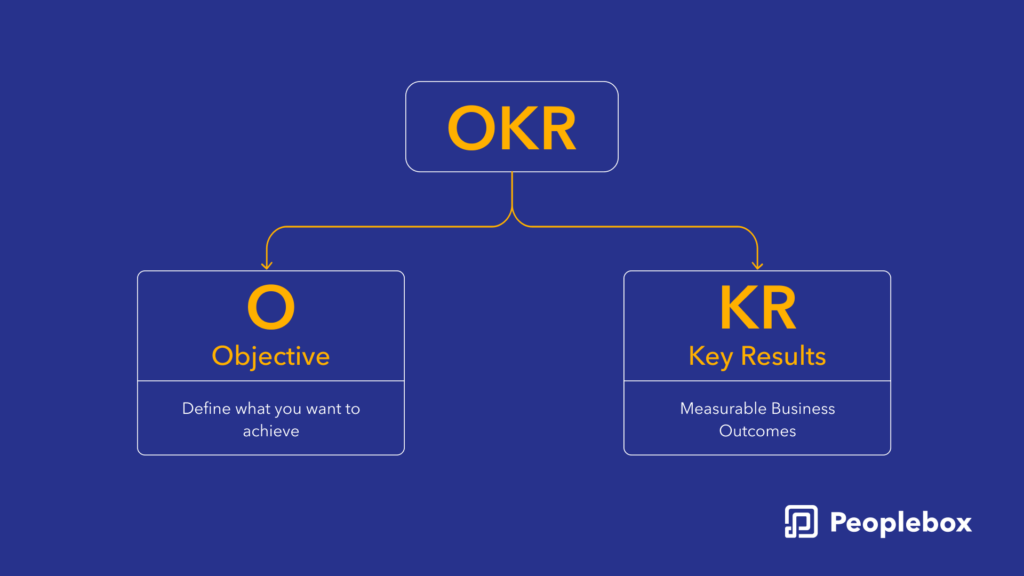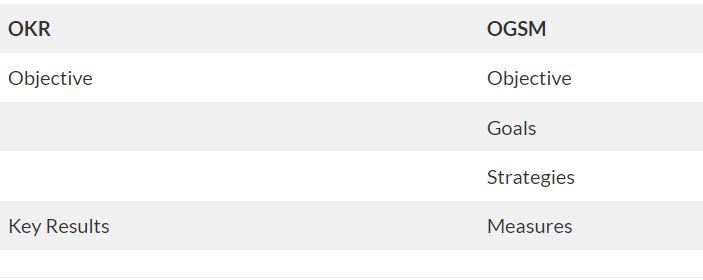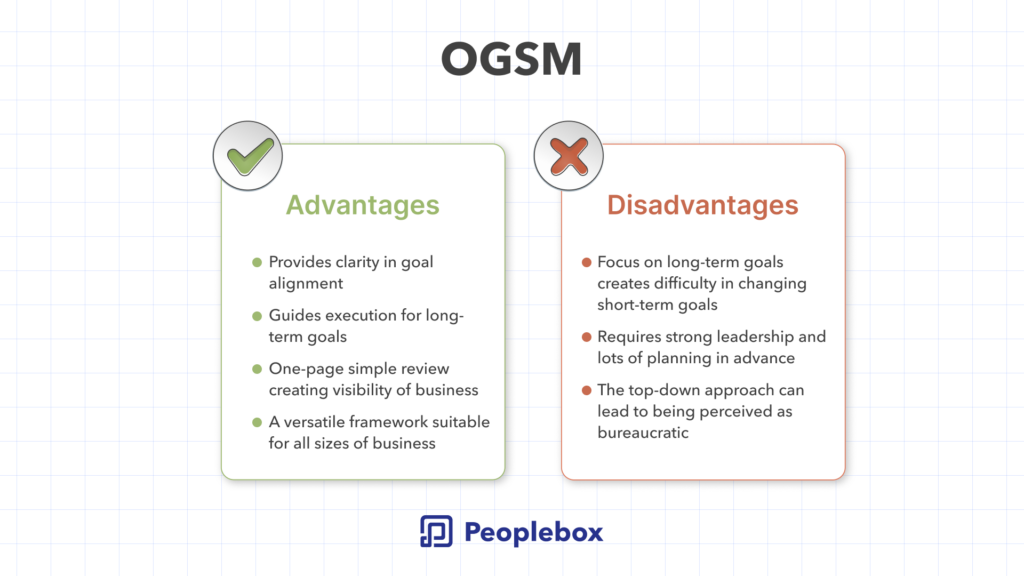We know by now that achieving our set goals is the key to success in this highly competitive market. For this, we set targets and aim to achieve them within a set deadline. But without a system or a process in place, we set ourselves for failure.
To avoid such an outcome, you can look into management methodologies like OKRs (Objectives and Key Results) and OGSM (Objectives, Goals, Strategies, and Measures).
Both methodologies are known to help organizations align their objectives, strategies, and actions to achieve their goals. The fundamental difference between the two lies in the level of detail and structure each provides. OKRs provide a straightforward approach to goal setting, while OGSM provides a more comprehensive framework.
Both approaches have their benefits and can be used in different situations. However, OKRs tend to be popular in fast-paced, dynamic environments. OGSM is more suitable for complex organizations with multiple departments and stakeholders.
Differences like these and many more can be explored in this blog. Our aim is to explore their differences by checking out their advantages and disadvantages. We’ll also help you identify which methodology would suit your organizational needs better.
So, let’s dive in.
What Is OKR and OGSM?
OKR

OKR is a goal-setting framework that helps organizations align their objectives and strategies with their overall vision and mission. It provides a clear and measurable way to track progress and ensure that everyone in the organization is working towards the same goal.
Each OKR consists of objectives and key results. Objectives are broad, aspirational statements that define what the organization wants to achieve. Key results are specific, measurable metrics that demonstrate progress towards the objective.
Example of OKR
Objective: Increase revenue from online sales by 30%
Key Result 1: Increase website traffic by 25% within the next quarter through targeted digital marketing campaigns, OKRs for Marketing.
KR 2: Increase the conversion rate of website visitors to customers by 15% within the next six months through website optimization and improved user experience.
KR 3: Launch at least two new products on the website within the next 12 months and achieve a 15% increase in revenue from these new products.
OGSM

OGSM is also a strategic planning framework that helps organizations align their strategies with vision. However, it differs in its approach and provides a comprehensive format by breaking it down into multiple levels. The OGSM methodology includes:
Objectives: Broad, aspirational statements that define what an organization wants to achieve.
Goals: Specific, measurable targets that support the objectives. It provides a roadmap for achieving them.
Strategies: The actions and plans that will help achieve the goals and support the objectives.
Measures: Metrics that will track progress and ensure the strategies are working as intended.
Example of OGSM
Objective: Increase company profitability
Goals:
- Increase revenue by 10% by next year.
- Reduce operational costs by 5% by next year.
Strategies:
- Expand into new markets through targeted marketing campaigns and partnerships.
- Improve operational efficiency through process optimization and technology upgrades.
- Launch at least two new products within the next year to diversify revenue streams.
Measures:
- Track revenue growth quarter-over-quarter and compare against the target.
- Monitor operational costs and compare them against the target.
- Track the success of new product launches and measure their contribution to revenue growth.
What Is the Main Difference Between OKR and OGSM?
In both OKRs and OGSM, the goal is to align objectives and strategies with the overall vision and mission of the organization
The main difference between OKRs and OGSM is the level of detail and structure each provides.
OKR is often used for short-term goals, usually three months. These short-term goals accumulate to help the business achieve its long-term goals. OKR breaks the long-term goals into smaller goals. OKRs follow a bi-directional approach and involve inputs from employees.
Whereas, OGSM is a strategic planning approach for long-term business planning. It follows the top-down approach. The top level communicates the strategies and policies through individual divisions.
Major difference between OKR and OGSM
1. Terminology and format difference

OKR consists of objectives and key results, where objectives describe where we want to go, and the key results describe how we would get there. There are only 3-5 key results and they can be quantitative and qualitative.
OGSM, on the other hand, describes all the components in detail. The objectives and strategies are statements, and the goals and measures are clear numbers. It elaborates on the goals, and alignment and quantifies the long-term goals and objectives.
2. Scope of frameworks
OKR is best for team level and individual goal setting for aligning them to the overall business goal. It is the breakup of tasks for individual members within the specified cycle that combines with other member’s tasks to complete OKR.
OGSM is best for describing the strategic plans of the business. It travels from the top level to teams, product lines and individual departments.
3. Timeframe
OKRs are used for very short-term goals and the timeframe is usually a quarter. The OKRs are set for achieving in 3 months after which new OKRs are set and everything is aligned according to the quarterly time frame.
OGSM is used for long-term goals and the timeframe expands from 1 year to over 3-5 years as well. The objectives, goals, strategies and measures are set according to this timeframe. The changes in the strategies and adjustments are made after the quarterly reviews in OGSM.
4. Feedback and changes
OKRs emphasize a lot on regular check-ins, 1:1s and feedback from employees. OGSM does not have any set requirements for these and instead emphasizes setting benchmarks only. So, if some strategy is not working, it takes longer to identify and correct it.
Advantages and Disadvantages
We have understood the difference between OKR and OGSM. Both these methodologies come with their unique advantages and disadvantages. Let’s check those out.
OKR advantages and disadvantages

OGSM advantages and disadvantages

What to Apply: OKR or OGSM?
In the ongoing debate of OKR vs OGSM, it is important to understand what works best for your team.
OKR is a short-term framework and works best for teams and individuals. It is good for setting short-term goals as a part of big company goals.
- OKRs are usually quarterly goals and are suitable for dynamic environments where changes occur quickly.
- It is best for companies that want to stay agile
- It is best for tech companies and startups to get quick results who want to adapt and pivot quickly.
OGSM is suitable for long-term strategic planning and annual operating plans for companies of all sizes.
- It is best for large companies who want to plan their 3-5 years of growth strategy
- It can be applied as the outcome of a strategic business review
OKR vs OGSM: Which Is a Better Methodology?
While both these methodologies have their strengths and weaknesses, in their specific use cases, OKR is better. This is especially true when compared to OGSM in terms of strategy execution and tracking. Having said that, we also believe that you can get the best of both worlds when you combine these strategies.
Every company has long and short-term goals. Combining these methodologies yields better results by providing a robust goal management system. OGSM takes care of the company vision while OKR takes care of company targets.








